| View previous topic :: View next topic |
| Author |
Message |
Robson Vieira
Joined: 05 Jan 2017
Posts: 60
Location: São Paulo


|
 Posted: May 21, 2024 16:01 Post subject: Provide Miller indices in practice please Posted: May 21, 2024 16:01 Post subject: Provide Miller indices in practice please |
|
|
Hello my dear friends
I continue with trouble in Miller indices as a tool to ID a sample.
I feel confident with the theory and I can understand the concepts and main ideas but, I can't see how I can apply them to mineral identification in field. For me, the Miller indices seem to be conventional notations and formal standard ways to tell the things. Obviously, I'm wrong! Consider I collect an unknown sample, measure the angles and draw the shapes, identify the planes and even do the right orientation with Miller indices at all...how would that help me to identify the stuff? I'm trouble to get that. Can you help me?
Please, provide an example with a real "unknown" crystal sample and show us the step by step how Miller indices, symmetry and so on can be used to ID a mineral. I would be very happy. Thanks
Robson
|
|
| Back to top |
|
 |
Josele

Joined: 10 Apr 2012
Posts: 410
Location: Tarifa, Spain



|
 Posted: May 21, 2024 17:26 Post subject: Re: Provide Miller indices in practice please Posted: May 21, 2024 17:26 Post subject: Re: Provide Miller indices in practice please |
|
|
Miller indices determination is not an identification method but just a witty way to name crystal faces.
Knowing the crystal system of a sample in addition to hardness, density, streak color, kind of shine, striation and so on will narrow the possibilities of which specie can be.
Investigation process to know all these data and reach an accurate identification is to me the most satisfying side of mineral collecting.
|
|
| Back to top |
|
 |
James Catmur
Site Admin

Joined: 14 Sep 2006
Posts: 1479
Location: Cambridge



|
 Posted: May 22, 2024 04:17 Post subject: Re: Provide Miller indices in practice please Posted: May 22, 2024 04:17 Post subject: Re: Provide Miller indices in practice please |
|
|
I agree - I do not use Miller indices to identify specimens. Hardness, density, streak are where I start (but being colorblind makes streak color less useful to me, when on my own)
| Josele wrote: | Miller indices determination is not an identification method but just a way to name crystal faces.
Knowing the crystal system of a sample in addition to hardness, density, streak color, kind of shine, striation and so on will narrow the possibilities of which species can be.
Investigation process to know all these data and reach an accurate identification is to me the most satisfying side of mineral collecting. |
|
|
| Back to top |
|
 |
Bob Morgan
Joined: 18 Jan 2018
Posts: 251
Location: Savannah, Georgia



|
 Posted: May 22, 2024 07:59 Post subject: Re: Provide Miller indices in practice please Posted: May 22, 2024 07:59 Post subject: Re: Provide Miller indices in practice please |
|
|
I do a lot of face identification because I'm interested in unusual faces and other crystal features, but rarely find face identification useful for mineral identification. (Once I was sold a micro specimen identified as a spinel twin of pyrite which doesn't happen. It turned out to be magnetite.)
I usually traffic in form names rather than Miller Indices, although the Indices can be useful for distinguishing different faces of the same general form. There's a presentation of this for pyrite at the Rochester Academy of Science web site under the Mineral Section at: https://rasny.org/mineral-amazing-pyrite (link normalized by FMF)
Figuring out the mineral is my first step in face identification. What others have mentioned should be used for that. Going to Mindat and looking at photos from the same locality and finding someone who knows the locality or the particular mineral in question can also be quite helpful.
Then I orient the crystal - figure out which is the top or termination that should be on the top. From there most faces can be figured out rather straightforwardly.
From time to time, I've thought about writing an actual crystal illustrated guide for doing this or doing a few videos with actual specimens. I'm not sure there's enough interest. One mineral dealer was overheard advising a new dealer, "Don't worry about face identification, you will never make money with that."
|
|
| Back to top |
|
 |
Bob Carnein
Joined: 22 Aug 2013
Posts: 355
Location: Florissant, CO



|
 Posted: May 22, 2024 10:21 Post subject: Re: Provide Miller indices in practice please Posted: May 22, 2024 10:21 Post subject: Re: Provide Miller indices in practice please |
|
|
| Miller indices are just a "shorthand" way to describe features of crystals. Rather than saying that topaz has a single perfect cleavage direction that is perpendicular to the c axis, it's faster to say that is has (001) cleavage. If you want to use any reference beyond the most basic, you'll find that Miller indices are used to describe things like cleavage, twinning, crystal habits, and common vs. uncommon crystal faces. It's a useful concept to know if you want to go beyond the basic physical properties.
|
|
| Back to top |
|
 |
Roger Warin

Joined: 23 Jan 2013
Posts: 1242



|
 Posted: May 22, 2024 23:56 Post subject: Re: Provide Miller indices in practice please Posted: May 22, 2024 23:56 Post subject: Re: Provide Miller indices in practice please |
|
|
About Miller's indices.
Crystal morphology is one aspect of the collection.
I love tourmalines, the most beautiful cation bins in mineralogy, because the structure is rather imposed by the anions.
Tourmaline is characterized by relatively low symmetry, with no center. The 2 ends are therefore different.
Therefore the base is a pedion (single-sided shape).
Without determining the indices, we can distinguish the two poles: antilogous and analogous.
But biterminated crystals are rather rare (see my remark).
The tourmaline crystal is often a prism ending with a pointed pole or base. This summit is the antilogous pole. This pole is richer on faces than the other.
This morphology results from the fact that all the SiO4 tetrahedra are aligned in the same orientation.
In the past, before 1960, the measurement of dihedral angles (and therefore the Miller indices) confirmed the structure of the mineral. These measurements were essential to confirm (analyze) the chemical nature of the crystal.
Electronics and computers did not exist (for us), but IR, Raman, UV spectrometers did. Optical properties completed the crystallographer's toolbox (as jewelers still do).
Today, Miller's indices are just labels.
In fact, they are used directly in the crystallographic calculations which give the design of the crystal.
Their usefulness is to define a crystal face and for example to characterize a twin law.
Let me ask a question:
Since the antilogous pole is the usual apex of the tourmaline prism, it must be favored by more rapid growth than that of the analogous pole.
The base of the prism is the analogous pole, poor in faces when they are present.
The crystallization kinetics of the two poles are thus different. The elongation of the tourmaline crystal occurs preferentially towards the antilogous top.
This summit is either a base, the pedion (a single crystallographic face), or one or more pyramids.
What is your opinion on this?
| Mineral: | Liddicoatite |
| Locality: | | Anjanabonoina, Ambohimanambola, Betafo District, Vakinankaratra Region, Madagascar |  |
|
| Description: |
| tourmaline with antilogous and analogous poles |
|
| Viewed: |
10689 Time(s) |
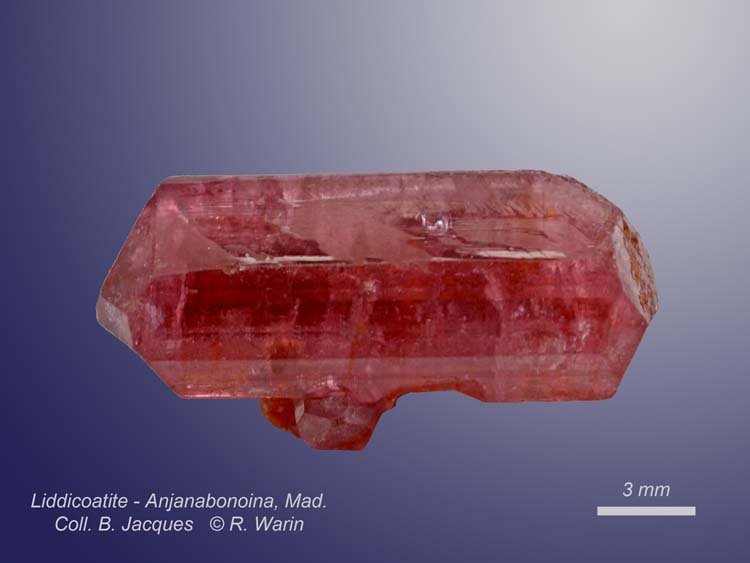
|
|
|
| Back to top |
|
 |
Robson Vieira
Joined: 05 Jan 2017
Posts: 60
Location: São Paulo


|
 Posted: May 23, 2024 12:59 Post subject: Re: Provide Miller indices in practice please Posted: May 23, 2024 12:59 Post subject: Re: Provide Miller indices in practice please |
|
|
Hi there,
It's True. I think I get the idea. I'd better to continue studying in order to achieve a higher degree of proficiency. I'm about to receive a piece which is named Euclase but I'm right it is Topaz, even by the image. The distinguishing ID characteristic would be the kind a cleavage, since they quite seemed. If I trouble with I'm going to post it to help.
Thanks
|
|
| Back to top |
|
 |
Pete Richards
Site Admin
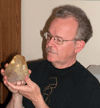
Joined: 29 Dec 2008
Posts: 846
Location: Northeast Ohio



|
 Posted: May 23, 2024 15:22 Post subject: Re: Provide Miller indices in practice please Posted: May 23, 2024 15:22 Post subject: Re: Provide Miller indices in practice please |
|
|
I'm a little slow to respond, but hopefully this will still be useful.
By themselves, Miller indices cannot be used to identify a mineral. Miller indices quantify the orientation of a face (or set of faces related by symmetry) to the symmetry axes of the crystal. But they do so within the coordinate system (the lattice) of the particular mineral, established from its unit cell. You need the unit cell and lattice to give a mathematical context to the Miller indices. Without it, the indices just indicate some very general things about the faces they name. If you have the unit cell, you can look it up and find the species, with or without the Miller indices.
It takes two sets of Miller indices (for two faces) to compute an interfacial angle, which can be useful in confirming a possible mineral identification, but again the calculation involves the parameters of the unit cell. The Miller indices alone are not much help.
Faces with the same Miller indices, such as {111}, can have very different appearances on crystals from different symmetry systems. It is usually easy to recognize {111} in the full symmetry class of isometric system, because it the octahedron. But in a lower symmetry class of the isometric system, it is a tetrahedron. In the tetragonal system, it could be a flat bipyramid, and in the triclinic system it would be only one or two faces on the crystal, and additional forms with different Miller indices would need to be present to fully describe the crystal. In the drawings below, the faces of the form {111} are colored yellow. Additional {111} faces are hidden on the back sides of the crystals.
Morphological crystallography, of which Miller indices are a part, is a rich and historically important field of study, and can be quite useful in choosing between possible identities of a mineral which forms good crystals, but only as one of many tools. Miller indices alone will not do it.
| Description: |
| Faces of {111} (yellow) in different minerals |
|
| Viewed: |
10602 Time(s) |
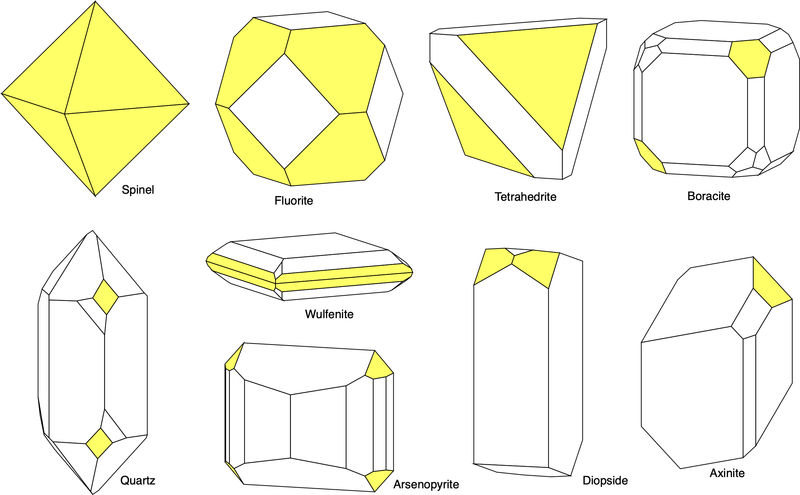
|
_________________
Collecting and studying crystals with interesting habits, twinning, and epitaxy |
|
| Back to top |
|
 |
Pete Richards
Site Admin

Joined: 29 Dec 2008
Posts: 846
Location: Northeast Ohio



|
 Posted: May 23, 2024 15:37 Post subject: Re: Provide Miller indices in practice please Posted: May 23, 2024 15:37 Post subject: Re: Provide Miller indices in practice please |
|
|
About tourmaline: statements about the complexity of terminations and polarity are apparently pretty reliable, but I always wonder. The polar nature of the tourmaline leads to several properties that can be used to determine which end is which with certainty. One involves heating (or cooling) a crystal, whereupon it develops a negative charge at one end and a positive charge at the other. Traditionally, the crystal is heated while suspended from a thread (to insulate it so the charges are not neutralized by contact with a ground) and then sprinkled with a powder mix of sulfur and red lead oxide. One is attracted to the negative end, the other to the positive end. Of course, you have to know which goes to which end to get your answer, and I forget which way it goes.
I once did the same determination, but by cooling the tourmaline in liquid nitrogen, and attracting it with a nylon rod, rubbed with a cloth to develop a charge. The rod attracted the end of the crystal with the opposite charge, which allowed the direction of the polarity to be determined.
However, few people will do this experiment even once, much less with each of their crystals. So we rely on generalizations about morphology to make an informed guess.
The antilogous end of the crystal does grow faster, at least according to one publication that sectioned some crystals that grew around earlier grains of tourmaline worn down to sand. The cross-sectional pattern, revealed by color changes, supports this more rapid growth. Also, I collected a suite of small Maine tourmalines on matrix, all of which had black caps. Some had simple pedions for terminations (presumably the analogous end), while others had more complex morphology (the antilogous end). The black cap, which must have been the final stage of growth, was about three times as thick on the antilogous end as on the analogous end.
| Description: |
| Tourmaline growth on an earlier tourmaline sand grain, showing more rapid growth towards the antilogous direction. |
|
| Viewed: |
10612 Time(s) |

|
| Mineral: | elbaite |
| Locality: | | Berry-Havey Quarry (Havey Quarry), Poland, Androscoggin County, Maine, USA |  |
|
| Description: |
| Crystal showing the apparent antalogous end with thicker (faster) growth of the dark termination. |
|
| Viewed: |
10597 Time(s) |
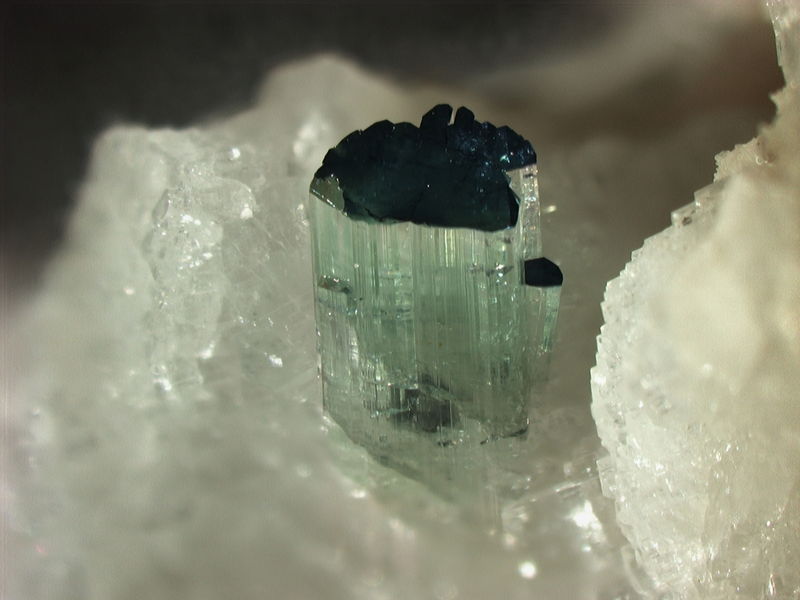
|
| Locality: | | Berry-Havey Quarry (Havey Quarry), Poland, Androscoggin County, Maine, USA |  |
|
| Description: |
| Crystal showing faster growth on antilogous end |
|
| Viewed: |
10579 Time(s) |
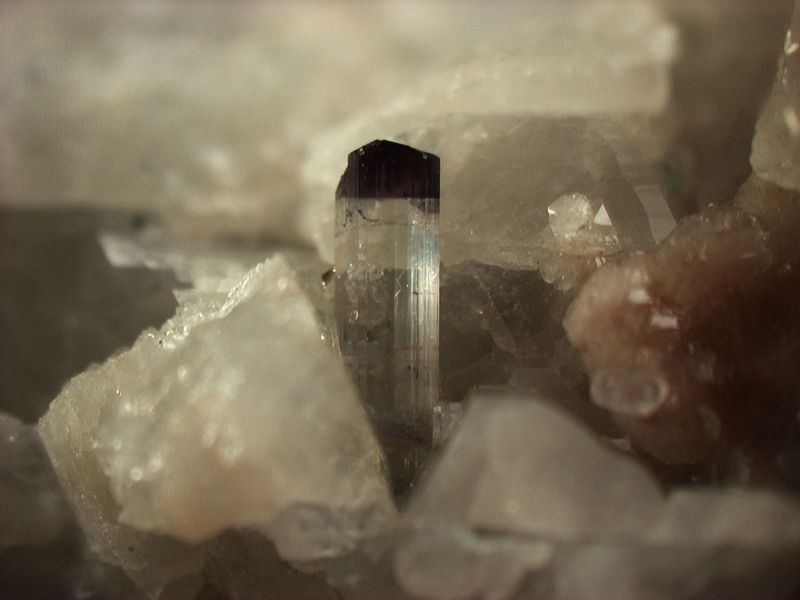
|
| Locality: | | Berry-Havey Quarry (Havey Quarry), Poland, Androscoggin County, Maine, USA |  |
|
| Description: |
| Crystal showing thinner (slower growth) dark zone on analogous end of crystal |
|
| Viewed: |
10577 Time(s) |
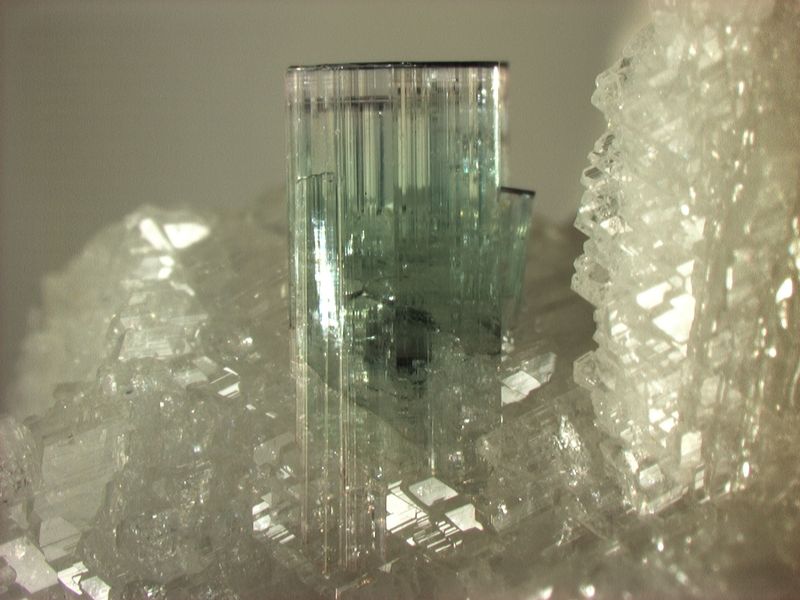
|
| Locality: | | Berry-Havey Quarry (Havey Quarry), Poland, Androscoggin County, Maine, USA |  |
|
| Description: |
| Crystal showing thinner dark layer on analogous end, indicating slower growth |
|
| Viewed: |
10604 Time(s) |
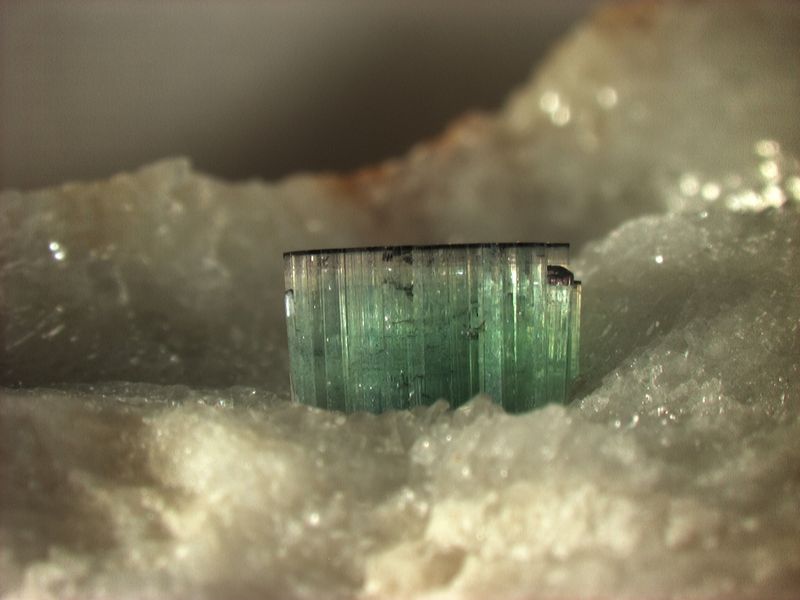
|
_________________
Collecting and studying crystals with interesting habits, twinning, and epitaxy |
|
| Back to top |
|
 |
Bob Carnein
Joined: 22 Aug 2013
Posts: 355
Location: Florissant, CO



|
 Posted: May 23, 2024 16:25 Post subject: Re: Provide Miller indices in practice please Posted: May 23, 2024 16:25 Post subject: Re: Provide Miller indices in practice please |
|
|
Robson: I think you get the point. Yes, it would be helpful if you post a photograph of your crystal. It would also be helpful to break the crystal, but I'm sure you won't want to do that!!
Another thing that is especially useful for mineral identification (besides physical properties) is mineral and rock associations. You can often eliminate a large number of possible identities by identifying other minerals that are present. As an example, euclase would not normally occur with olivine, but it would occur with topaz. It occurs in granite pegmatite but isn't likely to be found in metamorphic rocks. | Robson Vieira wrote: | Hi there,
It's True. I think I get the idea. I'd better to continue studying in order to achieve a higher degree of proficiency. I'm about to receive a piece which is named Euclase but I'm right it is Topaz, even by the image. The distinguishing ID characteristic would be the kind a cleavage, since they quite seemed. If I trouble with I'm going to post it to help.
Thanks |
|
|
| Back to top |
|
 |
Robson Vieira
Joined: 05 Jan 2017
Posts: 60
Location: São Paulo


|
 Posted: May 30, 2024 09:47 Post subject: Re: Provide Miller indices in practice please Posted: May 30, 2024 09:47 Post subject: Re: Provide Miller indices in practice please |
|
|
| Bob Carnein wrote: | Robson: I think you get the point. Yes, it would be helpful if you post a photograph of your crystal. It would also be helpful to break the crystal, but I'm sure you won't want to do that!!
Another thing that is especially useful for mineral identification (besides physical properties) is mineral and rock associations. You can often eliminate a large number of possible identities by identifying other minerals that are present. As an example, euclase would not normally occur with olivine, but it would occur with topaz. It occurs in granite pegmatite but isn't likely to be found in metamorphic rocks. | Robson Vieira wrote: | Hi there,
It's True. I think I get the idea. I'd better to continue studying in order to achieve a higher degree of proficiency. I'm about to receive a piece which is named Euclase but I'm right it is Topaz, even by the image. The distinguishing ID characteristic would be the kind a cleavage, since they quite seemed. If I trouble with I'm going to post it to help.
Thanks |
|
Hi guy, yeah. You are right. There are a bunch of tests and approaches to do, one adding something to another. Fortunately, the most mineral one a person like me can own will not need X ray fluorescence and other high-grade technology to identify.
|
|
| Back to top |
|
 |
Robson Vieira
Joined: 05 Jan 2017
Posts: 60
Location: São Paulo


|
 Posted: May 30, 2024 09:49 Post subject: Re: Provide Miller indices in practice please Posted: May 30, 2024 09:49 Post subject: Re: Provide Miller indices in practice please |
|
|
Hi folks,
I'm really thankful you all by your attention. Make me clear the question.
See you later.
Robson
|
|
| Back to top |
|
 |
|





